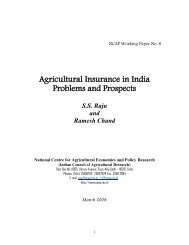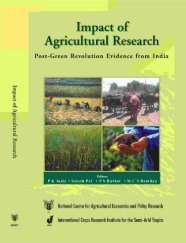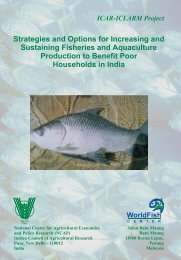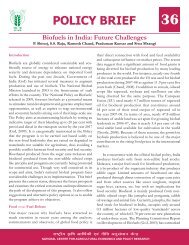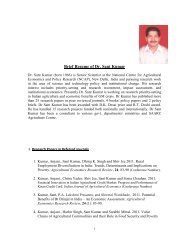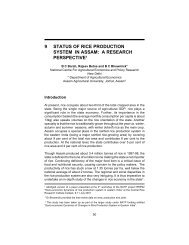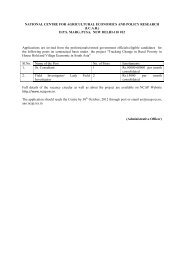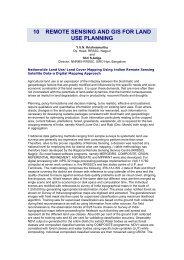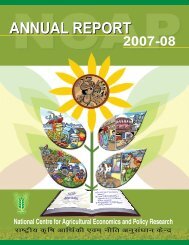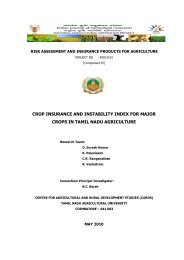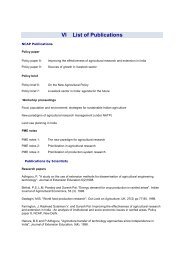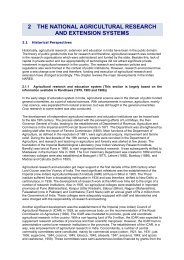Instability in Indian Agriculture - NCAP
Instability in Indian Agriculture - NCAP
Instability in Indian Agriculture - NCAP
You also want an ePaper? Increase the reach of your titles
YUMPU automatically turns print PDFs into web optimized ePapers that Google loves.
Ramesh Chand and S S Raju<br />
<strong>in</strong>itially proposed and used by Hazell (1982) and subsequently applied<br />
by Larson et al., and Sharma et al.<br />
This paper preferred to use the method proposed by Ray (1983b) and<br />
applied by Ray (1983a), Mahendradev (1987) and Rao et al., (1988) to<br />
estimate <strong>in</strong>stability <strong>in</strong> agricultural production. This method is given by:<br />
“<strong>Instability</strong> <strong>in</strong>dex = Standard deviation of natural logarithm (Y t+1<br />
/<br />
Y t<br />
)”<br />
where, Y t<br />
is the area / production / yield <strong>in</strong> the current year and, Y t+1<br />
is<br />
for the next year. This <strong>in</strong>dex is unit free and very robust, and it measures<br />
deviations from the underly<strong>in</strong>g trend (log l<strong>in</strong>ear <strong>in</strong> this case). When<br />
there are no deviations from trend, the ratio of Y t+1<br />
/ Y t<br />
is constant and<br />
thus standard deviation is zero. As the series fluctuates more, the ratio of<br />
Y t+1<br />
and Y t<br />
also fluctuates more, and standard deviation <strong>in</strong>creases.<br />
3.2 Effect of Choice of Period on <strong>Instability</strong><br />
It is pert<strong>in</strong>ent to po<strong>in</strong>t out that the selection or length of period can<br />
result <strong>in</strong> significant changes <strong>in</strong> <strong>in</strong>stability particularly if two sub periods<br />
with different dimensions of <strong>in</strong>stability or pooled <strong>in</strong>to one. This is<br />
demonstrated <strong>in</strong> Table 1 for foodgra<strong>in</strong>s at all India level. The table<br />
presents estimates of <strong>in</strong>stability (C.V.) derived from detrended yield,<br />
detrended production and production taken as product of the detrended<br />
area and detrended yield, as used by Hazell (1982), Larson et al., (2004)<br />
and Sharma et al., (2006).<br />
<strong>Instability</strong> <strong>in</strong> foodgra<strong>in</strong> yield measured by the CV <strong>in</strong> detrended yield<br />
was 4.50 <strong>in</strong> pre green revolution period (same as reported by Larson et<br />
al., 2004) and, it <strong>in</strong>creased to 5.06 <strong>in</strong> the post green revolution period<br />
that covers the period 1968 to 1988. Variability <strong>in</strong> yield dropped to 3.72<br />
after 1989 <strong>in</strong>dicat<strong>in</strong>g a decl<strong>in</strong>e of 26.5 per cent <strong>in</strong> the second phase of<br />
green revolution as compared to the first phase and a decl<strong>in</strong>e of 17.3 per<br />
cent compared to pre green revolution period. If both these sub periods<br />
are pooled then <strong>in</strong>stability <strong>in</strong> yield turns out to be 5.50 which is 22.2<br />
per cent higher than the pre green revolution period. These differences<br />
... 11 ...



